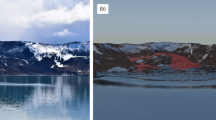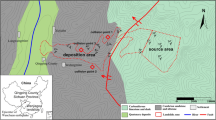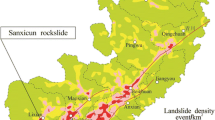Abstract
In this research, we studied the distribution of impact melt layers underneath Xiuyan crater using hydrocode simulation. The target was modeled by granite based on the rock type distribution around the crater and projector by iron, because most small and isolated terrestrial craters are formed by iron projectile. The simulated crater diameter and depth are 1 710 and 320 m, respectively, which are in good agreement with observations of 1 800 and 307 m (except for the post-impact lacustrine sedimentation). The validated model shows that impact melt materials were first formed along the transient crater floor and wall by highshock pressure, and then refilled inward the crater along with collapse of the crater wall. The final style of impact melt materials is interbedded with shock breccia underneath the crater center, which is verified through two layers in the borehole located in the crater center.
Similar content being viewed by others
References Cited
Amsden, A. A., Ruppel, H. M., Hirt, C. W., 1980. SALE: A Simplified ALE Computer Program for Fluid Flow at All Speeds. Report #LA-8095. Los Alamos National Laboratories, Los Alamos, New Mexico. 101
Chen, M., 2008. Impact-Derived Features of the Xiuyan Meteorite Crater. Chinese Science Bulletin, 53(3): 392–395. doi:10.1007/s11434-008-0004-3
Chen, M., Xiao, W. S., Xie, X. D., et al., 2010. Xiuyan Crater, China: Impact Origin Confirmed. Chinese Science Bulletin, 55(17): 1777–1781. doi:10.1007/s11434-010-3010-1
Chen, M., Koeberl, C., Xiao, W. S., et al., 2011. Planar Deformation Features in Quartz from Impact-Produced Polymict Breccia of the Xiuyan Crater, China. Meteoritics & Planetary Science, 46(5): 729–736. doi:10.1111/j.1945- 5100.2011.01186.x
Collins, G. S., Melosh, H. J., Ivanov, B. A., 2004. Modeling Damage and Deformation in Impact Simulations. Meteoritics & Planetary Science, 39(2): 217–231. doi:10.1111/j.1945-5100.2004.tb00337.x
Collins, G. S., Melosh, H. J., Marcus, R. A., 2005. Earth Impact Effects Program: A Web-Based Computer Program for Calculating the Regional Environmental Consequences of a Meteoroid Impact on Earth. Meteoritics & Planetary Science, 40(6): 817–840. doi:10.1111/j.1945- 5100.2005.tb00157.x
Grieve, R. A. F., 1978. The Melt Rocks at Brent Crater, Ontario, Canada. Proceeding of 9th Lunar Planetary Science Conference, March 13–17, Houston. 2579–2608
Grieve, R. A. F., Langenhorst, F., Stöffler, D., 1996. Shock Metamorphism of Quartz in Nature and Experiment: II. Significance in Geoscience. Meteoritics & Planetary Science, 31(1): 6–35. doi:10.1111/j.1945-5100.1996.tb02049.x
Ivanov, B. A., Deniem, D., Neukum, G., 1997. Implementation of Dynamic Strength Models into 2D Hydrocodes: Applications for Atmospheric Breakup and Impact Cratering. International Journal of Impact Engineering, 20(1–5): 411–430. doi:10.1016/s0734-743x(97)87511-2
Ivanov, B. A., Artemieva, N. A., 2011. Numerical Modeling of the Formation of Large Impact Craters. Geological Society of America Special Paper, 356: 619–630
Kinslow, R., 1970. High-Velocity Impact Phenomena. Academic Press, New York
Littlefield, D. L., 1997. ANEOS Extensions for Modeling Hypervelocity Impact. International Journal of Impact Engineering, 20(6–10): 533–544. doi:10.1016/s0734-743x(97)87442-8
Littlefield, D. L., Bauman, P. T., Molineux, A., 2007. Analysis of Formation of the Odessa Crater. International Journal of Impact Engineering, 34(12): 1953–1961. doi:10.1016/j.ijimpeng.2006.12.005
McGlaun, J. M., Thompson, S. L., Elrick, M. G., 1990. CTH: A Three-Dimensional Shock Wave Physics Code. International Journal of Impact Engineering, 10(1–4): 351–360. doi:10.1016/0734-743x(90)90071-3
Melosh, H. J., 1989. Impact Cratering: A Geologic Process. Oxford University Press, New York
Melosh, H. J., 2007. A Hydrocode Equation of State for SiO2. Meteoritics & Planetary Science, 42(12): 2079–2098. doi:10.1111/j.1945-5100.2007.tb01009.x
Melosh, H. J., Ryan, E. V., Asphaug, E., 1992. Dynamic Fragmentation in Impacts: Hydrocode Simulation of Laboratory Impacts. Journal of Geophysical Research, 97(E9): 14735. doi:10.1029/92je01632
Ohnaka, M., 1995. A Shear Failure Strength Law of Rock in the Brittle-Plastic Transition Regime. Geophysical Research Letters, 22(1): 25–28. doi:10.1029/94gl02791
O’Keefe, J. D., Ahrens, T. J., 1994. Impact-Induced Melting of Planetary Surfaces. Geological Society of America Special Paper, 293: 103–109
Osinski, G. R., Pierazzo, E., 2013. Impact Cratering: Processes and Products. Wiley-Blackwell, Hoboken, NJ
Pierazzo, E., Vickery, A. M., Melosh, H. J., 1997. A Reevaluation of Impact Melt Production. Icarus, 127(2): 408–423. doi:10.1006/icar.1997.5713
Pierazzo, E., Melosh, H. J., 2000. Melt Production in Oblique Impacts. Icarus, 145(1): 252–261. doi:10.1006/icar.1999.6332
Qin, G., Lu, D., Ou, Q., et al., 2001. The Discovery of PGE Anomaly and Platina from Luoquanli Impact Crater, China. Earth Science Frontier, 8(2): 333–338 (in Chinese with English Abstract)
Thompson S. L., Lauson, H. S., 1972. Improvements in the Chart D Radiation-Hydrodynamic CODE III: Revised Analytic Equations of State. Report SC-RR-71 0714. Sandia National Laboratory, Albuquerque. 119
Tonks, W. B., Melosh, H. J., 1993. Magma Ocean Formation Due to Giant Impacts. Journal of Geophysical Research, 98(E3): 5319. doi:10.1029/92je02726
Wang X. Y., Luo, L., Guo H. D., et al., 2013. Cratering Process and Morphological Features of the Xiuyan Impact Crater in Northeast China. Science China: Earth Sciences, 56(10): 1629–1638. doi:10.1007/s11430-013-4695-1
Wünnemann, K., Collins, G. S., Melosh, H. J., 2006. A Strain- Based Porosity Model for Use in Hydrocode Simulations of Impacts and Implications for Transient Crater Growth in Porous Targets. Icarus, 180(2): 514–527. doi:10.1016/j.icarus.2005.10.013
Wünnemann, K., Collins, G. S., Osinski, G. R., 2008. Numerical Modelling of Impact Melt Production in Porous Rocks. Earth and Planetary Science Letters, 269(3/4): 530–539. doi:10.1016/j.epsl.2008.03.007
Yue, Z. Y., Di, K. C., Zhang, P., 2012. Theories and Methods for Numerical Simulation of Impact Crater Formation. Earth Science Frontiers, 19(6): 110–117 (in Chinese with English Abstract)
Zhao, C. J., Liu, M. J., Fan, J. C., et al., 2011. High-Resolution Seismic Exploration of Xiuyan Impact Crater Structures. Chinese Journal of Geophysics, 54(6): 1559–1565 (in Chinese with English Abstract)
Acknowledgments
Part of this work was finished at Purdue University, and the first author appreciates the help by Prof. Jay Melosh. The authors acknowledge the developers of iSALE2D, including Gareth Collins, Kai Wünnemann, Boris Ivanov, Jay Melosh, and Dirk Elbeshausen. This study was supported by the National Natural Science Foundation of China (Nos. 41472303, 41490635). The final publication is available at Springer via http://dx.doi.org/10.1007/s12583-017-0741-9.
Author information
Authors and Affiliations
Corresponding author
Additional information
Zongyu Yue: http://orcid-org/0000-0002-8073-9264
Rights and permissions
About this article
Cite this article
Yue, Z., Di, K. Hydrocode simulation of the impact melt layer distribution underneath Xiuyan Crater, China. J. Earth Sci. 28, 180–186 (2017). https://doi.org/10.1007/s12583-017-0741-9
Received:
Accepted:
Published:
Issue Date:
DOI: https://doi.org/10.1007/s12583-017-0741-9




